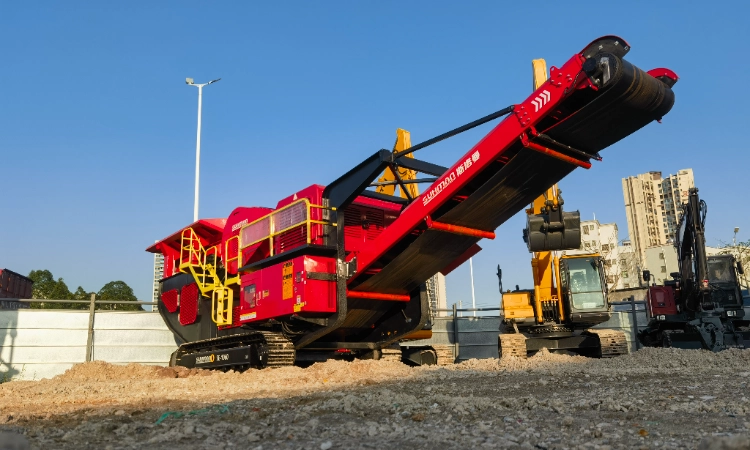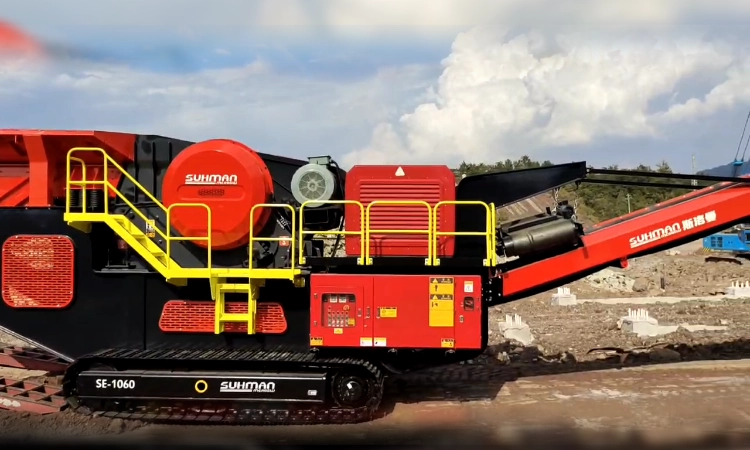The mobile screening plant has become a pivotal piece of equipment in industries such as construction, mining, agriculture, and waste management. These plants are essential for sorting, grading, and processing materials on-site, contributing to cost reductions and operational efficiency. As the demand for sustainable and cost-effective solutions increases, mobile screening plant technology has advanced significantly. This article delves into the technological advancements that have shaped mobile screening plants, their current capabilities, and what the future holds for these essential machines.

A mobile screening plant is a mobile, versatile machine used to sort materials based on specific sizes or qualities. These plants are designed to be easily transported and set up on construction, mining, or recycling sites. With vibrating screens, conveyors, and other processing components, mobile screening plants efficiently separate materials such as sand, gravel, crushed stone, and waste. The plants can screen materials by size, shape, and other attributes, making them integral in sectors that require material sorting on-site.
Key Features of Mobile Screening Plants:
- Mobility: Can be moved to different job sites, eliminating the need for transportation of raw materials.
- Efficiency: Processes large volumes of material rapidly.
- Cost-Effectiveness: Reduces operational costs associated with transportation and on-site material handling.
- Environmental Sustainability: Helps minimize transportation, fuel consumption, and waste generation.
Advancements in Mobile Screening Plant Technology
Over the years, mobile screening plants have evolved significantly, incorporating cutting-edge technologies that enhance their efficiency, flexibility, and environmental benefits. Below are some of the key technological advancements that have shaped mobile screening plant capabilities:
1. Integration of Automation and AI
One of the most significant advancements in mobile screening plants is the integration of automation and artificial intelligence (AI). These technologies enhance machine performance by enabling real-time decision-making and process adjustments. AI-powered systems can optimize material flow, adjust screen settings automatically, and monitor equipment performance remotely, reducing human intervention and minimizing operational errors.
2. Improved Screening Efficiency with Multi-Deck Screens
Traditional mobile screening plants were often limited by single-deck screens, which could only sort materials into one or two categories. However, modern plants are equipped with multi-deck screens, allowing them to separate materials into multiple grades in a single pass. This advancement drastically improves efficiency and throughput, making mobile screening plants more adaptable to various material types and industries.
| Feature | Traditional Screening Plants | Modern Mobile Screening Plants with Multi-Deck Screens |
|---|---|---|
| Screening Capacity | Limited to 1 or 2 grades | Capable of sorting into multiple grades at once |
| Efficiency | Lower throughput | Higher throughput, reduces sorting time |
| Material Versatility | Works best with uniform materials | Adaptable to different material types and sizes |
3. Fuel-Efficient and Hybrid Power Systems
The growing focus on sustainability has led to the development of more fuel-efficient and hybrid power systems for mobile screening plants. Newer models utilize hybrid engines that combine diesel and electric power, allowing for reduced fuel consumption while maintaining operational power. This advancement helps reduce the carbon footprint of mobile screening plants and makes them more suitable for eco-conscious industries.
4. Enhanced Durability and Wear Resistance
Mobile screening plants are exposed to harsh conditions, including abrasive materials and extreme weather. As such, manufacturers have focused on increasing the durability of these machines. The use of high-strength steel and wear-resistant linings has extended the lifespan of the screens and other critical components. These upgrades ensure that mobile screening plants can withstand extended periods of heavy use without compromising performance.
| Material Feature | Traditional Mobile Screening Plants | Modern Mobile Screening Plants |
|---|---|---|
| Durability | Prone to wear and tear | Use of wear-resistant materials for longer life |
| Maintenance | Requires frequent repairs | Low-maintenance with advanced components |
| Operational Life | Shorter operational life | Extended lifespan, more resilient to wear |
5. Remote Monitoring and Control
Advances in IoT (Internet of Things) technology have made it possible to remotely monitor and control mobile screening plants. Operators can track key parameters such as material throughput, engine performance, fuel consumption, and screen settings from a central location. This reduces the need for on-site supervision, enabling operators to manage several plants at once, boosting overall efficiency.
6. Compact and Modular Designs
Mobile screening plants have become more compact and modular in recent years. The design improvements make these plants easier to transport, set up, and integrate into a wide range of operations. The modular design allows users to configure the plant to suit different material types and processing needs. This adaptability ensures that mobile screening plants can be used across various industries, from construction to mining.
7. Eco-Friendly Features
With increasing environmental concerns, many mobile screening plants are now designed with eco-friendly features. These include dust suppression systems, noise reduction technologies, and energy-efficient engines. Dust suppression systems help prevent the release of harmful dust particles into the air, improving air quality on job sites, while noise reduction technologies minimize the impact on surrounding communities.

The Future of Mobile Screening Plant Technology
As the demand for mobile screening plants continues to grow, manufacturers are continually working to push the boundaries of innovation. Here are some of the future trends and technologies we can expect to see in mobile screening plants:
1. Autonomous Screening Plants
The future of mobile screening plants may include fully autonomous machines. These plants will be capable of operating independently, making decisions based on real-time data and conditions. Autonomous mobile screening plants will use AI, machine learning, and real-time monitoring to optimize performance without requiring human intervention. This trend aligns with the broader industry shift towards automation, which is set to revolutionize various sectors.
2. Advanced Material Separation Techniques
Innovations in material separation technology will allow mobile screening plants to sort more complex materials with greater precision. Future models may incorporate technologies like air classifiers and magnetic separators to handle diverse material streams. These advancements will help improve sorting accuracy, especially for materials that are difficult to separate using traditional methods.
3. Increased Use of Renewable Energy Sources
As the world shifts toward renewable energy, mobile screening plants may increasingly rely on solar power and battery-powered systems. These technologies will reduce reliance on fossil fuels, making mobile screening plants even more eco-friendly. Solar panels can be installed on the plant's surface to harness energy during daylight hours, while battery storage systems can store energy for nighttime use.
4. Data-Driven Optimization
With the increasing integration of sensors and IoT devices, future mobile screening plants will be able to collect vast amounts of operational data. This data will be analyzed using advanced algorithms and predictive analytics to optimize plant performance. By analyzing data on material throughput, equipment wear, and operational conditions, plant operators will be able to make informed decisions that enhance performance and minimize downtime.
5. Smart Maintenance Solutions
Maintenance in mobile screening plants will also see advancements through predictive maintenance technologies. Sensors placed on critical components will monitor wear and tear, alerting operators when parts need attention before they fail. This will reduce downtime and maintenance costs while increasing the plant's operational efficiency.
Benefits of Mobile Screening Plant Technology Advancements
The continuous technological advancements in mobile screening plants bring a multitude of benefits to industries that rely on material sorting and processing. These advancements result in:
- Higher Efficiency: With automation, AI, and multi-deck screens, plants can process materials more quickly and effectively.
- Cost Savings: Fuel-efficient engines, modular designs, and autonomous operations all contribute to reducing operating costs.
- Environmental Sustainability: Eco-friendly features such as dust suppression and energy-efficient systems help minimize the environmental impact.
- Enhanced Versatility: Modern mobile screening plants are adaptable to a wide variety of material types, industries, and operational conditions.

Why Choose Us as Your Mobile Screening Plant Supplier?
As a leading mobile screening plant manufacturer and supplier, our company is committed to providing high-quality, reliable, and cutting-edge screening solutions to meet the diverse needs of our clients. Whether you're in construction, mining, agriculture, or waste management, our mobile screening plants are designed to maximize efficiency and ensure optimal performance.
Our plants are equipped with the latest technologies, including multi-deck screens, hybrid power systems, and remote monitoring capabilities. We work closely with our clients to deliver customized solutions that fit their unique operational needs.
If you are interested in exploring how our mobile screening plants can enhance your operations, feel free to contact us today. Our team is ready to provide expert advice and help you find the perfect plant for your business.
